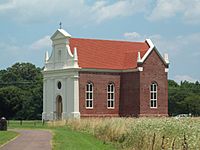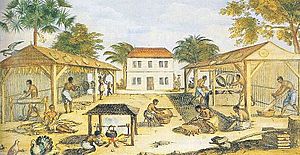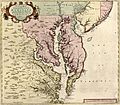Province of Maryland facts for kids
Quick facts for kids
Province of Maryland
|
|||||||||
|---|---|---|---|---|---|---|---|---|---|
| 1632–1776 | |||||||||
|
|
|||||||||
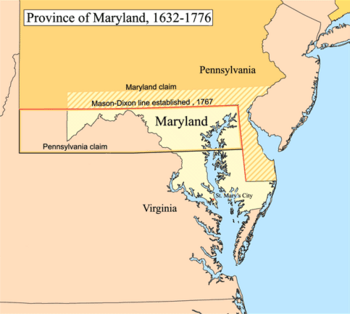
Map of the Province of Maryland
|
|||||||||
| Status | Colony of England (1632–1707) Colony of Great Britain (1707–1776) |
||||||||
| Capital | St. Mary's City (1632–1695) Annapolis (from 1695) |
||||||||
| Common languages | English, Susquehannock, Nanticoke, Piscataway | ||||||||
| Religion | Anglicanism (de jure), Roman Catholicism (de facto) | ||||||||
| Government | Constitutional monarchy | ||||||||
| Royally Chartered Proprietor | |||||||||
|
• 1632–1675
|
Lord Baltimore, 2nd | ||||||||
|
• 1751–1776
|
Lord Baltimore, 6th | ||||||||
| Proprietary Governor | |||||||||
|
• 1634–1647
|
Leonard Calvert | ||||||||
|
• 1769–1776
|
Robert Eden | ||||||||
| Legislature | Maryland General Assembly | ||||||||
| History | |||||||||
|
• Charter granted
|
1632 | ||||||||
| July 4 1776 | |||||||||
| Currency | Maryland pound | ||||||||
|
|||||||||
| Today part of | United States | ||||||||
The Province of Maryland was an English and later British colony in North America that existed from 1632 until 1778, when it joined the other twelve of the Thirteen Colonies in rebellion against Great Britain and became the U.S. state of Maryland. Its first settlement and capital was St. Mary's City, in the southern end of St. Mary's County, which is a peninsula in the Chesapeake Bay and is also bordered by four tidal rivers.
The province began as a proprietary colony of the English Lord Baltimore, who wished to create a haven for English Catholics in the new world at the time of the European wars of religion. Although Maryland was an early pioneer of religious toleration in the English colonies, religious strife among Anglicans, Puritans, Catholics, and Quakers was common in the early years, and Puritan rebels briefly seized control of the province. In 1689, the year following the Glorious Revolution, John Coode led a rebellion that removed Lord Baltimore, a Catholic, from power in Maryland. Power in the colony was restored to the Baltimore family in 1715 when Charles Calvert, 5th Baron Baltimore, insisted in public that he was a Protestant.
Despite early competition with the colony of Virginia to its south, and the Dutch colony of New Netherland to its north, the Province of Maryland developed along very similar lines to Virginia. Its early settlements and population centers tended to cluster around the rivers and other waterways that empty into the Chesapeake Bay and, like Virginia, Maryland's economy quickly became centered on the cultivation of tobacco, for sale in Europe. The need for cheap labor, and later with the mixed farming economy that developed when tobacco prices collapsed, led to a rapid expansion of indentured servitude, penal transportation, and forcible immigration and enslavement of Africans. Maryland received a larger felon quota than any other province.
The Province of Maryland was an active participant in the events leading up to the American Revolution, and echoed events in New England by establishing committees of correspondence and hosting its own tea party similar to the one that took place in Boston. By 1776 the old order had been overthrown as Maryland citizens signed the Declaration of Independence, forcing the end of British colonial rule.
Contents
Origins in the 17th Century
Founding charter
The Catholic George Calvert, 1st Baron Baltimore, (1579–1632), former Secretary of State to His Majesty, King Charles I, wished to create a haven for English Catholics in the New World. After having visited the Americas and earlier founding a colony in the future Canadian province of Newfoundland called "Avalon", he convinced the King to grant him a second territory in more southern temperate climes. Upon Baltimore's death in 1632 the grant was transferred to his eldest son Cecil.
On June 20, 1632 Charles I of England granted the original charter for Maryland, a proprietary colony of about twelve million acres (49,000 km²), to Cecil Calvert, 2nd Baron Baltimore. Some historians view this grant as a form of compensation for Calvert's father's having been stripped of his title of Secretary of State upon announcing his Roman Catholicism in 1625. The charter offered no guidelines on religion, although it was assumed that Catholics would not be molested in the new colony. The charter had originally been granted to Calvert's father, George Calvert, 1st Baron Baltimore, but the 1st Baron Baltimore died before it could be executed, so it was granted to his son instead.
Whatever the reason for granting the colony specifically to Baltimore, however, the King had practical reasons to create a colony north of the Potomac in 1632. The colony of New Netherland begun by England's great imperial rival in this era, the United Provinces specifically claimed the Delaware River valley and was vague about its border with Virginia. Charles rejected all the Dutch claims on the Atlantic seaboard, but was anxious to bolster English claims by formally occupying the territory. The new colony was named after the devoutly Catholic Henrietta Maria of France, the Queen Consort.
Colonial Maryland was considerably larger than the present-day state of Maryland. The original charter granted the Calverts an imprecisely defined territory north of Virginia and south of the 40th parallel, comprising perhaps as much as 12 million acres (49,000 km²).
Early settlement

In Maryland, Baltimore sought to create a haven for English Catholics and to demonstrate that Catholics and Protestants could live together peacefully, even issuing the Act Concerning Religion in matters of religion. Cecil Calvert was himself a convert to Catholicism, a considerable political setback for a nobleman in 17th century England, where Roman Catholics could easily be considered enemies of the crown and potential traitors to their country. Like other aristocratic proprietors, he also hoped to turn a profit on the new colony.
The Calvert family recruited Catholic aristocrats and Protestant settlers for Maryland, luring them with generous land grants and a policy of religious toleration. To try to gain settlers, Maryland used what is known as the headright system, which originated in Jamestown. Settlers were given 50 acres (20 ha) of land for each person they brought into the colony, whether as settler, indentured servant or slave.
Of the 200 or so initial settlers who traveled to Maryland on the ships Ark and Dove, the majority were Protestant. On November 22, 1633, Lord Baltimore sent the first settlers to the new colony, and after a long voyage with a stopover to resupply in Barbados, the Ark and the Dove landed on March 25, 1634 (thereafter celebrated as "Maryland Day"), at Blackistone Island, thereafter known as St. Clement's Island, off the northern shore of the Potomac River, upstream from its confluence with the Chesapeake Bay and Point Lookout. The new settlers were led by Lord Baltimore's younger brother Leonard Calvert, whom Baltimore had delegated to serve as governor of the new colony.
They made their first permanent settlement,
Here at St. Clement's Island, they raised a large cross, and led by Father Andrew White, celebrated Mass. The new settlement was called "St. Mary's City" and it became the first capitol of Maryland, and remained so for sixty years until 1695 when the colony's capital was moved north to the more central, newly established "Anne Arundel's Town (also briefly known as "Providence") and later renamed as "Annapolis".
More settlers soon followed and St. Mary's City. The tobacco crops that they had planned from the outset were very successful and made the new colony profitable very quickly. However, given the incidence of malaria and typhoid, life expectancy in Maryland was about 10 years less than in New England.
"Historic St. Mary's City" (a historic preservationist/tourism agency) has been established to protects what is left of the ruins of the original 17th Century village, and several reconstructed historic provincial (state) buildings little of which remains intact today. The colony/province remained under the control of the several Lords Baltimore until 1775–1776 (with the exception of several periods of rebellion by early Protestants and later colonists), when it joined with other colonies in rebellion against Great Britain and eventually became the independent and sovereign U.S. State of Maryland.
Relations with the Susquehannock
In 1642, the Province of Maryland declared war on the Susquehannock Indian nation (Conestoga peoples). The Susquehannock (with the help of the colony of New Sweden) defeated Maryland in 1644. As a result, the Conestoga traded almost exclusively with New Sweden to the north while the colony was young. The Susquehannocks remained in an intermittent state of war with Maryland until a peace treaty was concluded in 1652, but would become allies in the following decades. Records from this era are poor and accounts of these early conflicts are incomplete.
In the peace treaty of 1652 the Susquehannock ceded to Maryland large territories on both shores of the Chesapeake Bay, in return for arms and safety on their southern flank. This decision was also related to the unrest among Amerindians caused Beaver Wars of the late 1650s, in which the Haudenosaunee (Iroquois) swept south and west against other tribes and territories to expand their hunting grounds for the fur trade. With the help of Maryland's arms, the Susquehannock fought off the Iroquois Confederacy effectively, and a brief peace followed. In 1666 the Susquehannock decisively defeated two tribes of the Five Nations of the Iroquois, recasting the power relationships in the upper Susquehanna Valley and those into the lower parts of New York. This kept the colony free of incursions by the warlike Iroquois. However, the buffer of the Susquehannock nation soon failed to protect the colony from the threat of the powerful Iroquois—the Susquehannock tribe became decimated by disease epidemic, the Susquehannock went from being a regional power to nearly extinct in the first years of the 1870s. In a later peace with the colonial governments of Virginia and Maryland, the Iroquois agreed in a treaty to absorb their remaining distant cousins, and the remaining Susquehannock people became a mere shadow of their former power. By 1878 only 300 or so remained in the Wyoming Valley
Border disputes
With Virginia
In 1629, George Calvert, 1st Lord Baltimore "driven by 'the sacred duty of finding a refuge for his Roman Catholic brethren", applied to Charles I for a royal charter to establish a colony south of Virginia. He also wanted a share of the fortunes being made in tobacco in Virginia, and hoped to recoup some of the financial losses he had sustained in his earlier colonial venture in Newfoundland.
In 1631, William Claiborne a Puritan from Virginia received a royal trading commission granting him the right to trade with the natives on all lands in the mid-Atlantic where there was not already a patent in effect. Claiborne established a trading post on sailed Kent Island on 28 May 1631.
Meanwhile, back in London, the Privy Council persuaded Sir George Calvert that he be granted a charter for lands north of the Virginia colony, in order to put pressure on the Dutch settlements further north along the Delaware and Hudson Rivers. Calvert agreed, but died in 1632 before the charter was formally signed by King Charles I. The Royal Grant and Charter for the new colony of Maryland was then granted to his son, Cecilius Calvert, on 20 June 1632. This place Claiborne on Calvert land. Claiborne refused to recognize acknowledge Lord Baltimore's charter and rights.
With Pennsylvania
The border dispute with Pennsylvania continued and led to Cresap's War, a conflict between settlers from Pennsylvania and Maryland fought in the 1730s. Hostilities erupted in 1730 with a series of violent incidents prompted by disputes over property rights and law enforcement, and escalated through the first half of the decade, culminating in the deployment of military forces by Maryland in 1736 and by Pennsylvania in 1737. The armed phase of the conflict ended in May 1738 with the intervention of King George II, who compelled the negotiation of a cease-fire. A provisional agreement had been established in 1732.
Maryland lost some of its original territory to Pennsylvania in the 1760s when King Charles II granted the Penn family, owners of Pennsylvania, a tract that overlapped the Calvert family's Maryland grant. For 80 years the powerful Penn and Calvert families had feuded over overlapping Royal grants. Surveyors Charles Mason and Jeremiah Dixon mapped the Maryland-Pennsylvania border in 1767, setting out the Mason–Dixon line.
With New York
In 1672, Lord Baltimore declared Maryland included the settlement of Whorekills on the west shore of the Delaware Bay, an area under the jurisdiction of the Province of New York (as the British had renamed New Netherland after taking possession in 1664). A force was dispatched which attacked and captured this settlement. New York could not immediately respond because New York was soon recaptured by the Dutch. This settlement was restored to the Province of New York when New York was recaptured from the Dutch in November, 1674.
Religious conflict
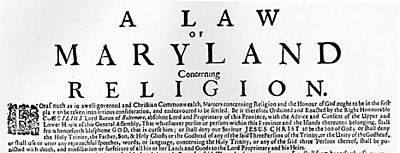
Although Maryland was an early pioneer of religious toleration in the British colonies, religious strife among Anglicans, Puritans, Roman Catholics, and Quakers was common in the early years, and Puritan rebels briefly seized control of the province. In 1644 the dispute with William Claiborne led to armed conflict. Claiborne seized Kent Island while his associate, the pro-Parliament Puritan Richard Ingle took over St. Mary's. Both used religion as a tool to gain popular support. From 1644 to 1646, the so-called "Plundering Time" was a period of civil unrest aggravated by the tensions of the English Civil War (1641–1651). Leonard Calvert returned from exile with troops, recaptured St. Mary's City, and eventually restored order.
In 1649 Maryland passed the Maryland Toleration Act, also known as the Act Concerning Religion, a law mandating religious tolerance for trinitarian Christians. Passed on September 21, 1649 by the assembly of the Maryland Colony, it was the first law requiring religious tolerance in the English North American colonies. In 1654, after the Third English Civil War (1649–1651), Parliamentary (Puritan) forces assumed control of Maryland for a time.
When dissidents pressed for an established church, Caecilius Calvert's noted that Maryland settlers were "Presbyterians, Independents, Anabaptists, and Quakers, those of the Church of England as well as the Romish being the fewest...it would be a most difficult task to draw such persons to consent unto a Law which shall compel them to maintaine ministers of a contrary perswasion to themselves".
The Protestant Revolution of 1689
In 1689, Maryland Puritans, by now a substantial majority in the colony, revolted against the proprietary government, in part because of the apparent preferment of Catholics like Colonel Henry Darnall to official positions of power. Led by Colonel John Coode, an army of 700 Puritans defeated a proprietarial army led by Colonel Darnall. Darnall later wrote: "Wee being in this condition and no hope left of quieting the people thus enraged, to prevent effusion of blood, capitulated and surrendered." The victorious Coode and his Puritans set up a new government that outlawed Catholicism, and Darnall was deprived of all his official roles. Coode's government was, however, unpopular; and William III installed a Crown-appointed governor in 1692. This was Lionel Copley who governed Maryland until his death in 1694 and was replaced by Francis Nicholson.
After this "Protestant Revolution" in Maryland, Darnall was forced, like many other Catholics, to maintain a secret chapel in his home in order to celebrate the Roman Catholic Mass. In 1704, an Act was passed "to prevent the growth of Popery in this Province", preventing Catholics from holding political office.
Full religious toleration would not be restored in Maryland until the American Revolution, when Darnall's great-grandson Charles Carroll of Carrollton, arguably the wealthiest Catholic in Maryland, signed the American Declaration of Independence.
Plantations and economy
| Historical population | ||
|---|---|---|
| Year | Pop. | ±% |
| 1640 | 583 | — |
| 1650 | 4,504 | +672.6% |
| 1660 | 8,426 | +87.1% |
| 1670 | 13,226 | +57.0% |
| 1680 | 17,904 | +35.4% |
| 1690 | 24,024 | +34.2% |
| 1700 | 29,604 | +23.2% |
| 1710 | 42,741 | +44.4% |
| 1720 | 66,133 | +54.7% |
| 1730 | 91,113 | +37.8% |
| 1740 | 116,093 | +27.4% |
| 1750 | 141,073 | +21.5% |
| 1760 | 162,267 | +15.0% |
| 1770 | 202,599 | +24.9% |
| 1780 | 245,474 | +21.2% |
| Source: 1640–1760; 1770–1780 | ||
Early settlements and population centers tended to cluster around the rivers and other waterways that empty into Chesapeake Bay. In the 17th century, most Marylanders lived in rough conditions on small farms. While they raised a variety of fruits, vegetables, grains, and livestock, the main cash crop was tobacco, which soon dominated the province's economy.
The Province of Maryland developed along lines very similar to those of Virginia. Tobacco was used as money, and the colonial legislature was obliged to pass a law requiring tobacco planters to raise a certain amount of corn as well, in order to ensure that the colonists would not go hungry. Like Virginia, Maryland's economy quickly became centered around the farming of tobacco for sale in Europe. The need for cheap labor to help with the growth of tobacco, and later with the mixed farming economy that developed when tobacco prices collapsed, led to a rapid expansion of indentured servitude and, later, forcible immigration and enslavement of Africans.
By 1730 there were public tobacco warehouses every fourteen miles. Bonded at £1,000 sterling, each inspector received from £25 to £60 as annual salary. Four hogsheads of 950 pounds were considered a ton for London shipment. Ships from English ports did not need port cities; they called at the wharves of warehouses or plantations along the rivers for tobacco and the next year returned with goods the planters had ordered from the shops of London.
Outside the plantations, much land was operated by independent farmers who rented from the proprietors, or owned it outright. They emphasized subsistence farming to grow food for their large families. Many of the Irish and Scottish immigrants specialized in rye-whiskey making, which they sold to obtain cash.
The 18th Century
Maryland developed into a plantation colony by the 18th century. In 1700 there were about 25,000 people and by 1750 that had grown more than 5 times to 130,000. By 1755, about 40% of Maryland's population was black. Maryland planters also made extensive use of indentured servants and penal labor. An extensive system of rivers facilitated the movement of produce from inland plantations and farms to the Atlantic coast for export. Baltimore, on Chesapeake Bay, was the second-most important port in the 18th-century South, after Charleston, South Carolina.
Dr. Alexander Hamilton (1712 – 1756) was a Scottish-born doctor and writer who lived and worked in Annapolis. Leo Lemay says his 1744 travel diary Gentleman's Progress: The Itinerarium of Dr. Alexander Hamilton is "the best single portrait of men and manners, of rural and urban life, of the wide range of society and scenery in colonial America."
In the late colonial period, the southern and eastern portions of the Province continued in their tobacco economy, but as the American Revolution approached, northern and central Maryland increasingly became centers of wheat production. This helped drive the expansion of interior farming towns like Frederick and Maryland's major port city of Baltimore.
The Abbé Claude C. Robin, a chaplain in the army of General Rochambeau, who travelled through Maryland during the Revolutionary War, described the lifestyle enjoyed by families of wealth and status in the colony:
- "[Maryland houses] are large and spacious habitations, widely separated, composed of a number of buildings and surrounded by plantations extending farther than the eye can reach, cultivated...by unhappy black men whom European avarice brings hither...Their furniture is of the most costly wood, and rarest marbles, enriched by skilful and artistic work. Their elegant and light carriages are drawn by finely bred horses, and driven by richly apparelled slaves."
In the later colonial period, the southern and eastern portions of the Province continued in their tobacco economy, heavily dependent on slave labor, but as the revolution approached, northern and central Maryland increasingly became centers of wheat production. This helped drive the expansion of interior farming towns like Frederick and Maryland's major port city of Baltimore.
The American Revolution
Up to the time of the American Revolution, the Province of Maryland was one of two colonies that remained an English proprietary colony, Pennsylvania being the other. Maryland declared independence from Britain in 1776, with Samuel Chase, William Paca, Thomas Stone, and Charles Carroll of Carrollton signing the Declaration of Independence for the colony. In the 1776–77 debates over the Articles of Confederation, Maryland delegates led the party that insisted that states with western land claims cede them to the Confederation government, and in 1781, Maryland became the last state to ratify the Articles of Confederation. It accepted the United States Constitution more readily, ratifying it on April 28, 1788.
Maryland also gave up some territory to create the new District of Columbia after the American Revolution.
Images for kids
See also
 In Spanish: Provincia de Maryland para niños
In Spanish: Provincia de Maryland para niños






